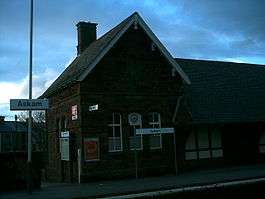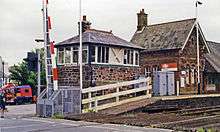Askam railway station
| Askam | |
|---|---|
 The northbound platform | |
| Location | |
| Place | Askam-in-Furness |
| Local authority | Barrow-in-Furness |
| Coordinates | 54°11′20″N 3°12′18″W / 54.189°N 3.205°WCoordinates: 54°11′20″N 3°12′18″W / 54.189°N 3.205°W |
| Grid reference | SD215777 |
| Operations | |
| Station code | ASK |
| Managed by | Northern |
| Number of platforms | 2 |
| DfT category | F2 |
|
Live arrivals/departures, station information and onward connections from National Rail Enquiries | |
| Annual rail passenger usage* | |
| 2012/13 |
|
| 2013/14 |
|
| 2014/15 |
|
| 2015/16 |
|
| 2016/17 |
|
| National Rail – UK railway stations | |
| * Annual estimated passenger usage based on sales of tickets in stated financial year(s) which end or originate at Askam from Office of Rail and Road statistics. Methodology may vary year on year. | |
|
| |
Askam Railway Station serves the villages of Askam-in-Furness and Ireleth in Cumbria, England. The railway station is a stop on the scenic Cumbrian Coast Line. Some through trains to the Furness Line stop here. It is operated by Northern who provide all passenger train services. Originally, the station was built here to transport the iron ore being mined in Askam out of the village.
History
The line
The railway along the Cumbrian coast was completed over many years by numerous small firms, who often would refuse to work together. However, eventually 'Grouping' forced the companies to work together on the railway, instead of constantly competing. Further problems were encountered when the people building the railway ran out of money, and so the proposed Duddon Viaduct, from Askam to Millom, was abandoned. Instead, a different route, going by way of Foxfield, was planned. This saved £37,000.[1]
The plans were drawn up in 1843, and shortly afterwards, sections of the Furness Railway were built. The original section through Askam, coming from Millwood Junction, and going on to Kirkby Slate Warf was part of the original railway line. This was officially opened on 3 June 1846. A passenger service then began operating on 24 August of that same year.[2]
The station
Originally, there was a simple stop in Askam. This was abolished in 1859; the later growth of Askam meant that it soon deserved a full sized station. In 1876 the vicar of Askam complained at a shareholders' meeting of the passenger accommodation at Askam:
They had both an up and down platform, but they were simply wooden railings with gravel banks. They were useful platforms, as they were used not only for passengers, but for cattle. On one side of the line, there was some slight covered accommodation, but in bad weather this was so thronged with men smoking and spitting that it was not suitable for ladies. On the other side, there was no covered accommodation, whatever, but the Station Master, like all other officials connected with the railway, was very kind to the public, by allowing them the use of the only room he had for living and cooking in.[3]
(The Furness Railway's managing director responded that there were various plans for the improvement of the station, but nothing could be done until a dispute over the provision of a bridge at the station was resolved.[3])
The station that was built was actually originally designed for Millom, by Paley and Austin. The chalet-style station was opened on 1 April 1868.[4]
Along with the station, sliding sheds were built next to the station. These were to store a banking locomotive, to aid trains with more than 16 wagons with the difficult climb to Lindal summit.[2]
As well as carrying ore, there were dozens of smaller lines to practically every mine, furnace and factory in the area. For example, the Askam brick works had a 2 ft gauge line to transport clay. This line was operational until 1968.[5]
Operational
Opened by the Furness Railway, it became part of the London, Midland and Scottish Railway during the Grouping of 1923. The station then passed to the London Midland Region of British Railways on nationalisation in 1948.
When Sectorisation was introduced in the 1980s, the station was served by Regional Railways until the Privatisation of British Railways.
Facilities
The station is not staffed and has no ticket machine, so passengers must buy their tickets in advance or on the train. The main building is grade II listed, but is not in railway use.[6] The platforms are linked by means of a barrier level crossing, controlled by a stone Furness Railway signal box on the northbound side.[7] Train running announcements are provided by telephone, information screens and posters. Step-free access is only available to the southbound platform (as the opposite one is reached by a short flight of steps).[8]
Services
Askam is one of the few mandatory stops on this section of the line (along with St Bees, Sellafield, Ravenglass & Millom) and as a result all trains call here. There is an approximately hourly service in each direction from the station on Monday to Saturdays – southwards to Barrow-in-Furness and northwards to Millom. Most northbound ones run through to and from Whitehaven and Carlisle though one runs only as far as Sellafield. A few trains continue beyond Barrow to Lancaster or to Preston.
A Sunday service was introduced at the May 2018 timetable change - the first for more than forty years.[9]
Gallery
 The station
The station View northwards 1998
View northwards 1998 Signal box and crossing
Signal box and crossing
Sources
- ↑ Rails Around the Cumbrian Coast. Dalesman Books. 1988. p. 3.
- 1 2 A Short History of Ireleth and Askam-in-Furness, by Mark Maclean.
- 1 2 "The Furness Railway". Lancaster Gazette. 26 August 1876.
- ↑ Rails Around the Cumbrian Coast. Dalesman Books. 1988. p. 49.
- ↑ Rails Around the Cumbrian Coast. Dalesman Books. 1988. p. 53.
- ↑ Askam Station Old Cumbria Gazetteer; Retrieved 1 December 2016
- ↑ Askam Station, looking north Thompson, N geograph.org; Retrieved 1 December 2016
- ↑ Askam station facilities National Rail Enquiries; Retrieved 1 December 2016
- ↑ GB National Rail Timetable May 2018, Table 100
References
- Butt, R. V. J. (1995). The Directory of Railway Stations: details every public and private passenger station, halt, platform and stopping place, past and present (1st ed.). Sparkford: Patrick Stephens Ltd. ISBN 978-1-85260-508-7. OCLC 60251199.
- Jowett, Alan (2000). Jowett's Nationalised Railway Atlas (1st ed.). Penryn, Cornwall: Atlantic Transport Publishers. ISBN 978-0-906899-99-1. OCLC 228266687.
External links
| Wikimedia Commons has media related to Askam railway station. |
- Train times and station information for Askam railway station from National Rail
- Askam station on navigable 1946 O. S. map
| Preceding station | Following station | |||
|---|---|---|---|---|
| Northern Cumbrian Coast Line Mondays-Saturdays only |